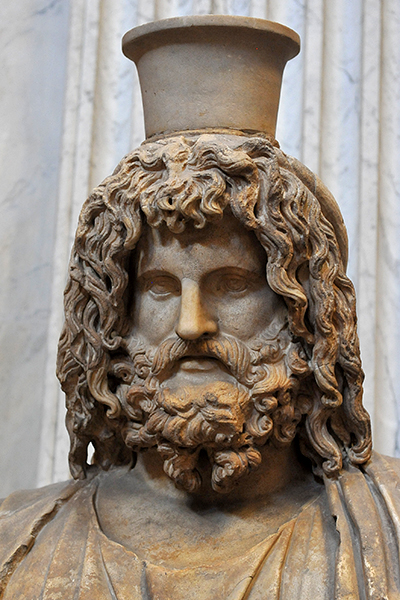"In the city on the borders of Egypt which boasts Alexander of Macedon as its founder, Sarapis and Isis are worshiped with a reverence that is almost fanatical. Evidence that the sun, under the name of Sarapis, is the object of all this reverence is either the basket set on the head of the god or the figure of a three-headed creature placed by his statue. The middle head of this figure, which is also the largest, represents a lion's; on the right a dog raises its head with a gentle and fawning air; and on the left the neck ends in the head of a ravening wolf. All three beasts are joined together by the coils of a serpent whose head returns to the god's right hand which keeps the monster in check."
Macrobius, Saturnalia (I.20.13)
Following the death of Alexander the Great in 323 BC, his generals (the Diadochoi) contended for power, with the satrapy of Egypt being ruled by Ptolemy I Soter, the first of the Macedonian kings to rule Egypt (323-283 BC). introduced a new syncretistic god to provide Alexandria with a patron deity and unite the Greek and Egyptian population of the city. Derived from Osiris and Apis, who had a cult at Memphis (where, in an underground chamber, the sacred bulls of Apis were ritualistically buried in massive stone sarcophagi), Serapis also came to be identified with Asclepius, the god of healing, as well as with Dionysus and Pluto. At his feet sat the three-headed dog Cerberus, the guardian of the underworld. Serapis was thought to appear to mortals in dreams, as did Isis, his Hellenized bride.
Lucius Apuleius, who was born in North Africa, relates, in the only surviving Latin novel, a dream in which Isis is revealed in all her manifestations.
"All the perfumes of Arabia floated into my nostrils as the Goddess deigned to address me: 'You see me here, Lucius, in answer to your prayer. I am Nature, the universal Mother, mistress of all the elements, primordial child of time, sovereign of all things spiritual, queen of the dead, queen also of the immortals, the single manifestation of all gods and goddesses that are...Though I am worshipped in many aspects, known by countless names, and propitiated with all manner of different rites, yet the whole round earth venerates me....call me by my true name, namely, Queen Isis.'"
Metamorphoses (XVII)
Ptolemy I also founded the great Library at Alexandria, which may have been adjacent to the Museum and was greatly augmented by his son Ptolemy II Philadelphus (285-246 BC). The collection was supplemented by an annex in the Temple of Serapis (or in the precinct around it), which was built by Ptolemy III Euergetes (246-221 BC). This "Daughter Library" was said to have contained more than forty-two thousand scrolls. The last of the Ptolemies, Cleopatra VII, was defeated at Actium in 31 BC and, failing to beguile Octavian as she had Mark Antony and Caesar, took her life the next year.
John Chrysostom, in his homily against the Jews, writes
"That you may know that the sacred books do not make a place holy but that the purpose of those who frequent a place does make it profane, I shall tell an old story. Ptolemy Philadelphus had collected books from all over the world. When he learned that the Jews had writings which treated of God and the ideal state, he sent for men from Judea and had them translate those books, which he then had deposited in the temple of Serapis, for he was a pagan. Up to the present day the translated books remain there in the temple. But will the temple of Serapis be holy because of the holy books? Heaven forbid! Although the books have their own holiness, they do not give a share of it to the place because those who frequent the place are defiled."
Adversus Judaeos (I.6.1)
The colossal marble bust of Serapis (above) was found in 1771 and sold to the Louvre by the British dealer Gavin Hamilton. On the head of the god is a calathus or modius, a basket or grain measure that held about a quarter of a bushel, symbolizing the fertility and bounty of the earth and an association with Osiris, the god of grain. Binding the hair is a plaited band which once held seven bronze rays that associated Serapis with the Sun god. The bust is dated to the end of the second century AD and is patterned after the cult statue in the Serapeum made about 320-310 BC, when the new god first was introduced. It was said to have been fashioned by Bryaxis, although not the sculpture of the Mausoleum at Halicarnassus but a namesake (Clement of Alexandria, Exhortation to the Heathen, IV).
Macrobius may be the same person to whom an edict of Theodosius I (CTh. XVI.10.15) was addressed as vicar of Spain, directing that "the ornaments of public works shall be preserved." Like the Attic Nights of Aulus Gellius, from which he quotes, the Saturnalia is a collection of excerpts and anecdotes on a variety of subjects presented as a conversation, in this case, among a number of eminent Roman pagans, including Symmachus.
References: Macrobius: The Saturnalia (1969) translated by Percival Vaughan Davies; Apuleius: The Golden Ass (1950) translated by Robert Graves (Penguin Classics); Saint John Chrysostom: Discourses Against Judaizing Christians (1979) translated by Paul W. Harkins (The Fathers of the Church, Vol. 68).
